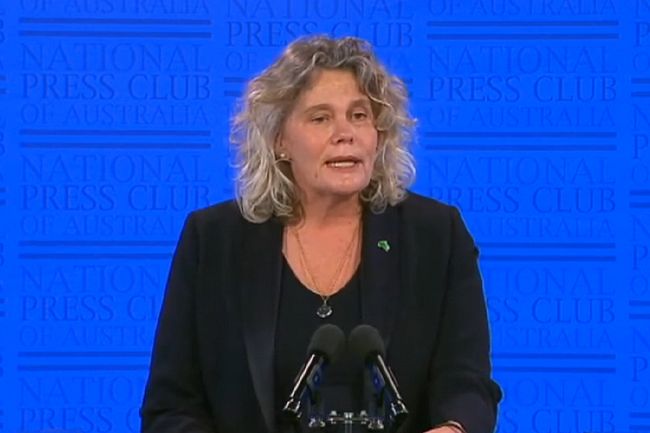Australia's farming sector lobby group is siding with the National Party and its reluctance to co-operate with emissions targets, writes David Paull.
AT A CRITICAL TIME when farmer lobby groups should be showing leadership in order to maximise the opportunities that new climate-adapted agriculture can offer, the National Farmers Federation (NFF) has decided to back the climate-denying National Party and continue with ambit claims based on disinformation that undermines the credibility of Australia at Glasgow COP26.
Standing on her Namoi Valley property for the ABC camera, the head of the National Farmers Federation, Fiona Simson, states her position for giving farmers a fair go under any future international agreement to reduce greenhouse emissions.
Key to this is an idea repeated by the Nationals recently in the media by Agriculture Minister David Littleproud and Resources Minister Keith Pitt to ‘reward farmers for their stewardship of the land’. But more than that, as Fiona articulated to the ABC, farmers need “compensation” for “doing the heavy lifting” imposed on them through the Kyoto Agreement, that being to retain bushland which has resulted in a loss of income for farmers.
As Fiona put it, the obligations imposed on farmers under Kyoto has created a “festering sore created by statutory theft”. Essentially, her claims follow the line that the Commonwealth made Kyoto commitments resulting in farmers’ property rights being taken away by the states to enforce these commitments and in doing so, halting land clearing and creating a surplus of credits.
As reported by The Guardian, the NFF says it supports an economy-wide aspiration of net zero emissions by 2050 — but with two conditions. It says emissions reduction needs to be economically viable and farmers must not be burdened by “unnecessary regulation”.
There is a lot to unpack here, but the NFF claims just don’t stack up.
Uptake of workable carbon sequestration schemes delayed
Currently, carbon sequestration schemes (both for soil and vegetation) for landowners have had a limited rollout and impact. This has primarily been because of the Government’s failure until recently to link soil carbon with an income stream and has not provided credits for the retention of remnant vegetation, along with other practical issues of the schemes reducing their effectiveness.
This has primarily been the fault of the recalcitrance of the National Party and the NFF who have generally been very cautious in supporting carbon-friendly methods.
The NFF has recently welcomed the carbon saving proposals of the Farmers for Climate Action but warned that it could not support any reforestation of “productive land” — land with better soil that has suffered disproportionately higher levels of biodiversity loss.
Importantly, as reported recently in The Guardian, when the first vegetation laws to regulate land clearing in NSW and Queensland were introduced, these had nothing to do with international carbon commitments but were due to concerns of widespread land clearing and its impacts on biodiversity and water. Kyoto came some seven years after these laws were introduced. Despite this, Simson claimed that the Government needed to compensate landholders for land clearing regulations that pre-dated the Kyoto period as a “goodwill exercise”.
Private land vegetation laws have not prevented land clearing
Despite the platitudes of government sources and those who have accepted this dogma, the introduction of private land vegetation laws in the early 1990s was not the end of land clearing at all. While the initial introduction saw the levels fall to what may be viewed from an environmental perspective to acceptable levels (up to 1 million hectares a year in Queensland between 1988-1990), subsequent changes to laws in Queensland and NSW have seen levels rise.
If we look at land clearing statistics since 2001, approximately 5 million hectares have been cleared in Queensland, while 2.5 million hectares have been cleared in NSW in the same time period (see WWF report here).
These figures include regrowth vegetation, but do not include illegal clearing undertaken outside the vegetation rules and largely unaccounted for in the official figures which is allowed clearing.
Emissions from land use change still rising
As the National Party-sponsored roadmap was revealed today, the Commonwealth Government has claimed we are on track to achieve a 35% reduction in emissions from 2001 levels and that previous forecasts have been conservative and will be accordingly adjusted. However, the assumptions underlying the figures for land use change should be treated with suspicion. Rather than providing enough credits to “offset” emissions from other sectors, it seems the Government has overstated gains from this sector.
According to the Government’s latest prediction in 2020, emissions from the Land Use, Land-Use Change and Forestry (LULUCF) sector (which includes land clearing, or ‘forest converted to other uses’) went from a total contribution of 91 MtCO2e (second biggest contributor to electricity) in 2001 to a negative contribution as a net sink in 2020 (-18 MtCO2e). How can this be, given the ongoing levels of land clearing during this period with a more recent spike since 2016 which do not appear to be reflected in the data?
The LULCF category is broken down in the March 2021 update to the national emissions figures (below). According to the Government, while grasslands, wetlands and croplands have remained more or less neutral, ‘land converted to forest’ (natural regrowth) and ‘forest land remaining forest’ have largely offset this loss from clearing. But why did standing forests become a significant net sink from 2013?

Even so, the Government is predicting another rise in the LULUCF category emmissions to 2030 when it will be -5 MtCO2e, a decrease of 13Mt equivalents on 2020 levels (Table 2, p.13 of Australia's Emissions Projections 2020).
Overall, the Government states in its 2020 report that:
‘Emissions to 2030 are projected to grow four per cent above 2020 levels, driven by higher emissions from LNG production, increased transport activity, a declining forest sink... and growth in agricultural activity after a return to average seasonal conditions.’
The Government is factoring in further expected carbon losses in part due to a decline in vegetation and soil carbon. In other words, they are not at all serious about future on-farm carbon sequestration.
Minimal loss of ‘property rights’
A reoccurring claim by the farming lobby and the National Party is that farmers have lost property rights to secure Australia’s emissions targets. This claim arises from the assumption that farmers have every right to remove every tree and bush from their properties and that there exists no public interest which should stand in their way.
One way of looking at this is to examine to what extent land has been set aside from routine agricultural practice, or as lobbyists say, “locked up”. In fact, native vegetation laws in Queensland and NSW have to a large degree accommodated the preservation of property rights through a number of exemptions that require no approval and an application process to be able to clear, making most remnant vegetation and regrowth still open for clearing and modification.
In Queensland, mapped “high risk” zones may still be cleared upon application, though endangered regional ecosystems cannot be removed. In NSW, endangered ecosystems can be cleared under certain circumstances and this state has embraced a system of self-assessment, whereby oversight by government experts is no longer necessary.
While Queensland now relies upon prohibiting clearing from the most sensitive ecosystems, NSW relies more on conservation agreements which are, in fact, voluntary. Most private land conservation agreements entered into by landholders are now registered under the Biodiversity Conservation Trust (BCT).
Many of these are agreements with sunset clauses (10-15 year agreements), while considerably fewer are “in perpetuity”. There are over 2,000 private land conservation agreements in NSW of various types suggesting a good uptake by landowners willing to enter such agreements. Hardly a transfer of property rights.
The Commonwealth also enters into conservation agreements, but has made little contribution with only 25 such agreements currently on their books, most arising through legal actions against the landowner or by the odd large corporation as signs of goodwill.
So, as the nation waits with bated breath as to the contents of the National Party’s “list of demands” for Australia to take to Glasgow, one wonders if it will contain the usual claims made by the private property and mining lobbies that have featured so strongly within the policy positions of the Party.
It has been stated in the media that senior government players who have been signalling agriculture will likely be excluded from any heavy lifting on abatement — but not from the income streams associated with carbon sequestration. Setting up a workable carbon credit scheme that provides incentive for landowners to retain remnant vegetation, improve soils and revegetate their properties should be the priority outcome. But will it, given the mixed signals?
Given the ongoing farm wars based on essentially a rewrite of history, misleading information and lukewarm commitments to farmers, will the position of the NFF and the National Party in fact jeopardise a legitimate voice for the agricultural sector and our chances of securing a forward-looking carbon plan for the agricultural sector? Judging by the past performance of these parties, only a fresh vision, such as championed by the Farmers for Climate Action is likely to give this country any credibility in the international sphere.
David Paull is an Australian ecologist and blogger on politics and the environment. You can follow David on Twitter @davesgas.
Related Articles
- IA Book Club: Confronting the global climate crisis
- Universities, governments and companies can help avert climate catastrophe
- Undeterred by pariah status, PM to wave 'green and gold' at Glasgow
- Flashback 2015: Coal comfort: The atomic emasculation of Malcolm Turnbull
- Billboard mocks Morrison as Australia prepares for COP26
 This work is licensed under a Creative Commons Attribution-NonCommercial-NoDerivs 3.0 Australia License
This work is licensed under a Creative Commons Attribution-NonCommercial-NoDerivs 3.0 Australia License
Support independent journalism Subscribe to IA.















